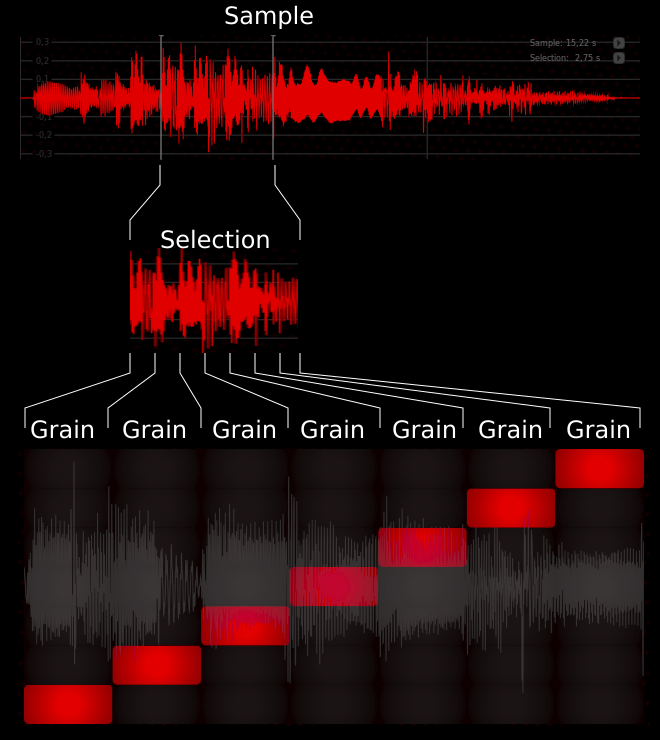B.Harvestr
Repository: BHarvestr
Description: B.Harvestr is an experimental granular synthesizer LV2 plugin.
Warning: B.Harvestr is in an early stage of development. Not for production use! No guarantees! Some essential features are not (fully) implemented yet. Major changes in the plugin definition need to be expected. Therefore, future versions of this plugin may be completely incompatible to this version.
Installation
Build your own binaries in the following three steps.
Step 1: Clone or download this repository.
Step 2: Install pkg-config and the development packages for x11, cairo, soundfile, and lv2 if not done yet. If you don't have already got the build tools (compilers, make, libraries) then install them too.
On Debian-based systems you may run:
sudo apt-get install build-essential
sudo apt-get install pkg-config libx11-dev libcairo2-dev libsndfile-dev lv2-dev
On Arch-based systems you may run:
sudo pacman -S base-devel
sudo pacman -S pkg-config libx11 cairo libsndfile lv2
Step 3: Building and installing into the default lv2 directory (/usr/local/lib/lv2/) is easy using make and
make install. Simply call:
make
sudo make install
Optional: Standard make and make install parameters are supported. Compiling using make CPPFLAGS+=-O3
is recommended to improve the plugin performance. Alternatively, you may build a debugging version using
make CPPFLAGS+=-g. For installation into an alternative directory (e.g., /usr/lib/lv2/), change the
variable PREFIX while installing: sudo make install PREFIX=/usr. If you want to freely choose the
install target directory, change the variable LV2DIR (e.g., make install LV2DIR=~/.lv2).
Running
After the installation Carla, Ardour and any other LV2 host should automatically detect B.Harvestr.
If jalv is installed, you can also call it
jalv.gtk https://www.jahnichen.de/plugins/lv2/BHarvestr
to run it stand-alone and connect it to the JACK system.
Granular synthesis
In contrast to standard synthesis methods which are based on oscillating waves, granular synthesis uses micro fragments of audio samples to generate sound. Thus, granular synthesis uses the same concept as (the majority of) pitch shifters. Granular synthesizers typically generate lots of overlapping grains to produce atmospheric sound effects, full soundscapes and pad sounds.
Starting point for granular synthesis is a sample. In theory, any kind of sample can be used. The sample is typically chopped by the granular synthesizer into fragments of 1 to 100 ms or sometimes even longer. These fragments are called grains. The grains are modulated and re-arranged to produce a new sound experience that may strongly differ from the initial sample.
Usage
Quick guide
Step 1 : Load a sample (or use the default sine wave)
Click on the file open symbol or the file name to select an audio source file.
Step 2 : Select a region
Drag the rulers in the sample window to select a region to use for granular synthesis. It is recommended to exclude the starting and the and region of the sample.
Also assign a note or a frequency to the selected region (default: A4 / 440 Hz).
Step 3 : Set grain size and/or grain rate
Change the grain size or rate by dragging or scrolling inside the ring of the respective dial. Shortening of the grain size may result in a deviation from the original sound. Decreasing the grain rate results in a staccato effect whereas increasing the rate may produce a fuller sound. Especially if some modulation is added.
Step 4 : Apply modulation
Set a modulation range for the grain properties by dragging or scrolling outside the ring of the respective dial. Click on the down button next to the respective dial and select up to four modulators for each property.
You can select between four envelopes, four LFOs, four sequencers, and four random engines. Randomness applied to grain properties may also prevent unwanted resonance produced by symmetrically overlaying grains.
Modulation can also be applied to the process properties. Process level needs to be connected to at least one envelope modulator (default: Env1).
TODO
- Extend MIDI support / features
- Pitch detection
- Add process features (filters, reverb, ...)
- Notify modulates process to GUI
- Find a better solution for the 1024 pattern steps limit
- Adjust output level to nr of grains
- Reduce CPU load !!!
- Use GPU for GUI effects
- Move notification handler to worker process
- Enable multi-line text edit
- Improve modulator selection dialog
- Keyboard mapping
- Write documentation
- Create presets
